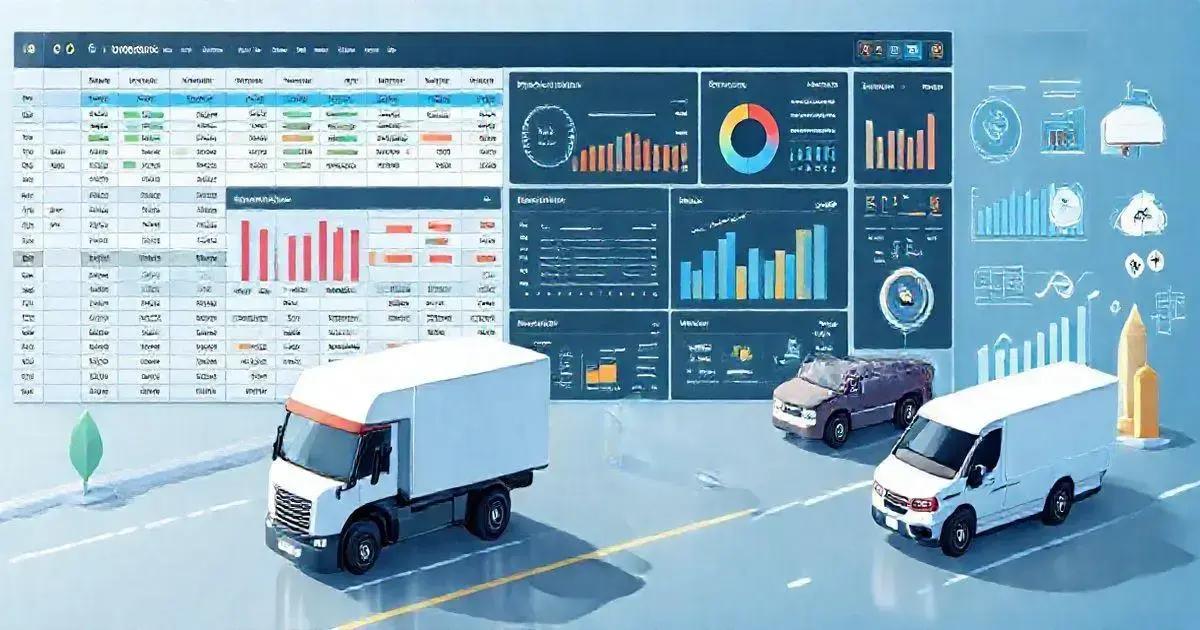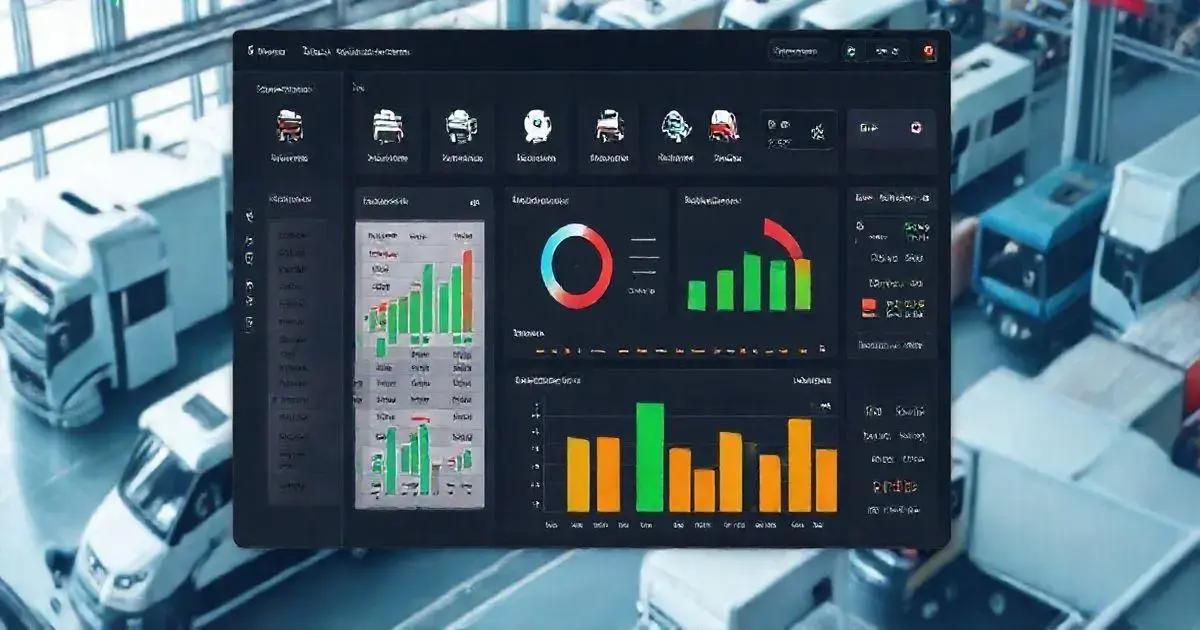Unlock Efficiency: Fleet Control Worksheet 7.0 Leave a comment
The Fleet Control Worksheet 7.0 is a powerful fleet management tool that enhances operational efficiency by providing dashboards for vehicle and driver performance, streamlining travel and cargo management, ensuring effective tire and maintenance control, organizing critical documentation, and analyzing vehicle life for informed decision-making, ultimately improving fleet performance, safety, and profitability.
The Fleet Control Worksheet 7.0 is a game-changer for businesses managing fleets of vehicles. This powerful spreadsheet template helps optimize operations, reduce costs, and enhance productivity by providing valuable insights into vehicle performance and maintenance.
Whether you are managing a small fleet or a large one, this worksheet offers features like travel and cargo control, tire maintenance tracking, and a comprehensive dashboard to keep everything organized and accessible.
Initial Dashboards
Initial Dashboards
The Fleet Control Worksheet 7.0 features a robust set of initial dashboards that provide crucial insights at a glance. These dashboards are designed to help fleet managers make informed decisions based on real-time data about vehicle performance and maintenance.
- KM by Driver: This metric displays the kilometers driven by each driver, allowing managers to assess driver efficiency and performance.
- KM per Vehicle: Analyze the distance traveled by each vehicle to identify usage patterns and ensure optimal resource allocation.
- KM per Liter: This dashboard item shows fuel efficiency, highlighting the kilometers driven relative to the amount of fuel consumed. It’s essential for identifying vehicles that may require maintenance or adjustments to improve fuel efficiency.
- KM per Trip: Understanding the distance covered per trip can help in route optimization and planning.
- Average Consumption per Vehicle: This dashboard tracks the average fuel consumption for each vehicle, providing insights into which vehicles may be less efficient.
- Average Consumption per Driver: Similar to vehicle consumption, this helps in evaluating and comparing driver performance based on fuel usage.
- Total General, Preventive and Corrective Maintenance: Track the total maintenance activities, separating them into general, preventive, and corrective, to manage budgets and schedules effectively.
- Maintenance Cost Average: Monitor the average costs associated with maintaining the fleet, which is vital for budgeting and financial planning.
- Total cost of Mechanical and Electrical Maintenance: This metric provides transparency on the overall mechanical and electrical maintenance expenses for the fleet, essential for strategic decision-making.
- Total Tire Maintenance Cost: Understand the costs associated with tire maintenance, which is crucial for managing operational expenses.
- Total Lubricant Cost: This helps in tracking lubricant expenses, ensuring proper budgeting for maintenance supplies.
- Average costs of Maintenance: Analyze average maintenance costs across different vehicles and drivers to identify areas for improvement.
- Average Tire Maintenance Cost: Assess tire maintenance costs on average for better financial planning.
- Average cost with Lubricants: Understand the average expenses related to lubricants to manage costs effectively.
- Vehicles in Transit: Keep a record of vehicles currently in transit to optimize routing and scheduling.
- Tires in Transit: Similar to vehicles, track tires that are in transit for maintenance or replacement, ensuring timely interventions.
- Delayed Vehicle Documents: Monitor the status of vehicle documents to avoid legal issues and ensure compliance.
- Delayed Driver Documents: Keep track of driver documentation to maintain compliance with regulations.
- Delayed Preventive Maintenance: This helps to manage preventive maintenance schedules and avoid costly breakdowns.
- Total Cost Versus Shipping: A crucial dashboard to understand the relationship between operational costs and shipping costs, helping balance profitability.
- Fuel, Maintenance and Other Costs: Track overall expenses related to fuel, maintenance, and other operational costs for comprehensive financial oversight.
With these initial dashboards, the Fleet Control Worksheet 7.0 empowers fleet managers to monitor performance effectively, make data-driven decisions, and enhance overall efficiency within their fleet operations.

Travel Control
The Travel Control section of the Fleet Control Worksheet 7.0 is designed to streamline and enhance the management of trips taken by your fleet. Efficient travel control is crucial for minimizing costs, maximizing operational efficiency, and ensuring that every journey is accounted for.
Cargo Control linked to Trips: This feature allows you to track the cargo associated with each trip, ensuring that all items are accounted for and delivered as planned. By linking cargo to specific trips, managers can easily address discrepancies or issues related to cargo delivery.
Vehicle Control: Monitor which vehicles are assigned to specific trips, providing a clear overview of fleet utilization. This control helps to ensure that the right vehicles are dispatched for the appropriate tasks, reducing wear and tear on vehicles that are not suited for certain jobs.
Driver Control: Keep track of which drivers are assigned to each trip. This oversight is essential for ensuring that drivers are appropriately qualified and that their working hours comply with regulations. It also allows for better performance evaluations based on individual trips.
Supply Control: Manage supplies required for each trip, including fuel, food, and other necessities. This control helps to ensure that all vehicles are adequately stocked before departure, minimizing delays and maximizing efficiency.
Control of All Travel Expenses: Document and monitor all expenses associated with each trip, including fuel costs, tolls, and any other related expenses. By keeping a close eye on travel expenses, fleet managers can identify cost-saving opportunities and negotiate better rates with suppliers.
Overall, the Travel Control features in the Fleet Control Worksheet 7.0 enhance the ability of fleet managers to oversee operations, mitigate risks, and ensure that every trip contributes positively to the bottom line. By implementing effective travel controls, businesses can optimize their fleet management strategies and improve overall operational efficiency.
Tire Control
The Tire Control section of the Fleet Control Worksheet 7.0 plays a vital role in ensuring that your fleet operates safely and efficiently. Proper tire management not only enhances vehicle performance but also significantly reduces maintenance costs and extends the lifespan of tires.
Tire Control
- Identification for Each Tire: Each tire in your fleet should have a unique identification system that allows for easy tracking of its usage, maintenance history, and performance metrics. This is essential for maintaining comprehensive records and facilitating future analyses.
- Tire Change Schedule by KM: Implement a tire change schedule based on the kilometers driven to ensure timely replacements. By keeping track of the distance each tire covers, fleet managers can anticipate when tires need to be replaced, helping to prevent accidents and costly breakdowns.
- Signal of How Much KM is Left to Change the Tire: This feature provides an alert system that notifies managers when tires are nearing their replacement limit based on the kilometers driven. It helps in proactive management, ensuring that tires are changed before they can cause safety issues.
- Status per Action: Track the status of each tire based on actions taken, such as allocation to a vehicle, removal for maintenance, scrapping, or routine maintenance checks. This can help in optimizing inventory management and improving the decision-making process for tire replacements.
By effectively managing tire control, the Fleet Control Worksheet 7.0 equips fleet managers with the tools needed to enhance safety, reduce costs, and maintain the overall efficiency of their operations. With a robust tire management system in place, businesses can expect improved fleet performance and fewer disruptions due to tire-related issues.

Maintenance Control
The Maintenance Control section of the Fleet Control Worksheet 7.0 is essential for ensuring that all vehicles in your fleet are operating at optimal performance. This section helps track both preventive and corrective maintenance, enabling fleet managers to minimize downtime and extend the life of their vehicles.
Corrective and Preventive Maintenance Type: Clearly categorize all maintenance tasks into corrective actions (repairs after issues arise) and preventive measures (scheduled maintenance to prevent issues). By identifying these categories, managers can better plan maintenance schedules and track their effectiveness.
Maintenance by Vehicle: This feature allows for detailed tracking of maintenance activities for each vehicle in the fleet. By maintaining records of what maintenance has been performed on each vehicle, fleet managers can assess vehicle health and make informed decisions about repairs or replacements.
Maintenance by Mechanical and Electrical Type, Tire and Lubricants: Track maintenance tasks based on their type, whether mechanical, electrical, tire-related, or for lubricants. This granular approach helps in identifying trends or recurring issues, facilitating more targeted maintenance strategies.
Maintenance Cost: Keep detailed records of all maintenance expenses associated with each vehicle. Understanding the cost of maintenance is crucial for budgeting and for calculating the total cost of ownership for each vehicle in the fleet.
Preventive Maintenance Schedule: Develop and manage a schedule for all preventive maintenance tasks, ensuring that they are completed on time. This proactive approach is vital for reducing unexpected breakdowns and enhancing the reliability of the fleet.
Preventive Maintenance Signal: Implement alerts or signals for upcoming preventive maintenance tasks based on vehicle usage and schedules. This feature ensures that no maintenance task is overlooked and that all vehicles remain in peak condition.
Status by: Track the status of maintenance tasks by categorizing them as scheduled, accomplished, or delayed. This feature provides visibility into maintenance operations, helping managers identify bottlenecks or inefficiencies in the process.
Overall, the Maintenance Control features in the Fleet Control Worksheet 7.0 provide fleet managers with a comprehensive framework for managing vehicle maintenance effectively. By adhering to a structured maintenance program, businesses can enhance vehicle reliability, lower operational costs, and improve overall safety.
Document Management
The Document Management section of the Fleet Control Worksheet 7.0 is crucial for ensuring that all necessary documentation for vehicles and drivers is organized, accessible, and up-to-date.
Proper document management helps fleet managers maintain compliance with regulations, reduces the risk of legal issues, and enhances overall operational efficiency.
Document Management
- Driver Document Control: This feature allows you to maintain records of all documentation related to drivers, including licenses, certifications, and training records. By keeping all driver documents organized, fleet managers can easily verify compliance and qualifications, ensuring that only authorized drivers operate vehicles.
- Vehicle Document Control: Similar to driver documents, this feature tracks all necessary vehicle documentation, such as registration, insurance, and inspection records. Efficient management of vehicle documents helps to prevent lapses in compliance and ensures that all vehicles are legally operational.
Effective document management in the Fleet Control Worksheet 7.0 empowers fleet managers to maintain a well-organized repository of important papers related to both vehicles and drivers.
By ensuring that all documents are properly managed and easily retrievable, businesses can operate more smoothly, react promptly to audits or inspections, and enhance overall safety within their fleet.

Vehicle Life Analysis
The Vehicle Life Analysis section of the Fleet Control Worksheet 7.0 provides fleet managers with critical insights into the lifecycle of each vehicle in the fleet. This analysis is essential for making informed decisions regarding vehicle maintenance, replacement, and overall fleet management strategies.
Travels Made: Track the total number of trips made by each vehicle over its lifespan. This metric helps identify usage patterns and assess how actively each vehicle is utilized, which can inform future purchasing decisions.
Loaded Loads: Monitor the total weight of loads transported by each vehicle. This information is crucial for understanding wear and tear, as heavier loads can significantly impact the longevity and maintenance needs of vehicles.
Travel Costs: Analyze the total costs incurred for each vehicle during its operational life, including fuel, maintenance, insurance, and depreciation. Understanding these costs helps fleet managers assess the financial performance of each vehicle and make smarter budgetary decisions.
Travel Supplies: Keep track of the supplies used during trips, such as fuel, lubricants, and maintenance parts. This feature provides insights into consumable costs associated with each vehicle, helping managers optimize procurement and inventory management.
By utilizing the Vehicle Life Analysis features in the Fleet Control Worksheet 7.0, fleet managers can gain a deeper understanding of each vehicle’s performance and costs throughout its lifecycle. This comprehensive analysis facilitates better planning for future investments, maintenance schedules, and overall fleet optimization, ultimately leading to improved operational efficiency and reduced costs.
Conclusion
In conclusion, the Fleet Control Worksheet 7.0 provides a comprehensive suite of tools designed to optimize fleet management across various dimensions, including travel control, tire management, maintenance oversight, document management, and vehicle life analysis.
By leveraging these features, fleet managers can gain valuable insights and enhance decision-making processes related to efficiency, safety, and cost management.
From tracking vehicle performance and maintenance costs to ensuring compliance with documentation, this worksheet empowers businesses to maintain their fleets effectively while minimizing operational risks.
As we navigate an ever-evolving transportation landscape, implementing a structured approach to fleet management is crucial for success.
Embracing the functionalities offered by the Fleet Control Worksheet 7.0 can lead to a more organized, efficient, and cost-effective fleet operation.
Investing in such tools is not just about managing assets; it’s about ensuring that your fleet operates smoothly and effectively, ultimately contributing to the overall success of your business.
FAQ – Frequently Asked Questions about Fleet Control Worksheet 7.0
What is the Fleet Control Worksheet 7.0?
The Fleet Control Worksheet 7.0 is an advanced spreadsheet template designed to help fleet managers optimize vehicle performance, track maintenance, manage documents, and analyze travel costs.
How does the Tire Control feature work?
The Tire Control feature allows fleet managers to track tire identification, schedule tire changes based on kilometers driven, and monitor the status of each tire, ensuring proper maintenance and replacement.
Can I manage documents for both drivers and vehicles?
Yes, the Document Management section allows you to keep track of all necessary documents for both drivers and vehicles, ensuring compliance and accessibility.
What insights can I gain from Vehicle Life Analysis?
Vehicle Life Analysis provides insights into usage patterns, travel costs, and the total number of trips made by each vehicle, helping managers make informed decisions about maintenance and replacements.
Is the Fleet Control Worksheet 7.0 suitable for all types of fleets?
Yes, the worksheet is adaptable and can be used for various types of fleets, whether small or large, across different industries.
How can I access support for the Fleet Control Worksheet 7.0?
Support is available through email, where you can receive assistance with any issues related to the installation or functionalities of the worksheet.

